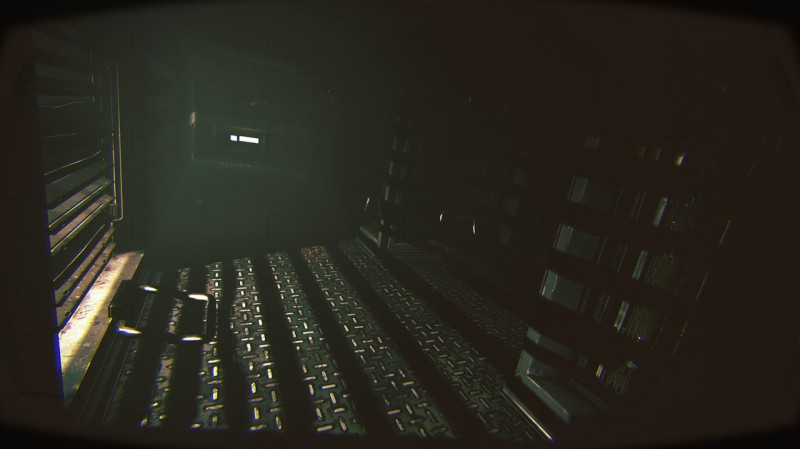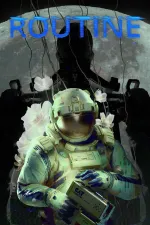Routine

Isolation can be terrifying; it’s the reason why so many horror games take place in abandoned asylums, mansions, or cities. But at least these places are on your home planet. The lonely protagonist of Lunar Software’s first-person horror title, Routine, is in the rough type of situation usually reserved for Isaac Clarke. Routine’s moon base is a derelict, leaving only trace evidence of its former crew and a powerful, unfeeling robot. We spoke with Aaron Foster, artist and designer of Routine, about the small UK team’s mission to craft a cold, inhospitable moon facility. We discuss classic sci-fi/horror inspirations, giving players a gun, and the process of developing a harrowing VR experience with the Oculus Rift.
The indie dev scene is brimming with first-person horror games inspired by Frictional’s disturbing Amnesia: The Dark Descent. Titles like Outlast, Among the Sleep, and Slender tap into Amnesia’s combat-free design, forcing players to run and hide rather that stand and fight. While Routine shares similarities with these titles, Foster originally envisioned it as a narrative-driven, Dear Esther-style experience light on gameplay. Foster began work on Routine following his departure from the now shuttered Eurocom (Dead Space: Extraction, GoldenEye 007) after working on the multiplayer platformer Disney Universe.
“It started when I was just on my own,” Foster says. “I took a look at what I was truly interested in and passionate about, because I’ve worked on a lot of projects in the past that I never finished because they weren’t passion projects. They were just things I wanted to try out and learn and have a go at, basically. But I recently quit my job in the industry. I was working as an environment artist. I wanted to make sure that the next project I did was something I truly cared about. Something that’s never changed since I was a kid was my love of science fiction and horror. So I just wanted to put those things together.”
Classic films like 2001: A Space Odyssey, The Thing, and Alien are longtime favorites of Foster’s and directly influenced Routine’s 1980s vision of a futuristic moon base. “Everything had this believable, weathered environment,” Foster says. “We had these white, chunky designs with dirt in the corners, CRT computers, and keyboards. But in our current vision of the future everything is sleek and cut-down, kind of like the iPod. Everything is touchscreens and holograms. To me, what I love about sci-fi back then was that everything was much more relatable.”
The ‘80s influence extends beyond the dingy computer monitors and crusty keyboards into the audio. The soundtrack and audio design are being handled by Australian artist Mick Gordan, whose works includes Need For Speed: The Run, Wolfenstein: The New Order, and the upcoming Killer Instinct title for Xbox One.
“He’s a super talented guy,” Foster says. “He’s a massive fan of horror. He has a massive Alien tattoo on his arm. Originally when I started the project and got him on board, I pitched all these ‘80s sound inspirations to him. He liked them all and everything, but he wanted to stray away from the usual ‘80s synth you hear in stuff like Far Cry 3: Blood Dragon and all that. Looking back at movies like The Shining, which is a really big inspirational Kubrick movie for audio, getting that uncomfortable feel with all these sounds. Not too much of the bleeps and such.”
Instead of the pings and whirs of the U.S.S. Enterprise, you’re more likely to hear the clunky sound of a decades-old computer hard drive booting up. “We’re trying to make it much more tangible and low-fi,” Foster says.
Routine’s main weapon and gadget, the Cosmonaut Assistance Tool, further drives home the clunky ‘80s future aesthetic with its boxy shape and floppy disk drive. The CAT is part gun, part utility/tech device. It holds two batteries which are used to power the screen, wireless capabilities, and debilitating blast. Shooting one of the clanking haywire robots wandering the moon base’s corridors may temporarily disable it, but the shot could also spend your last battery and leave you in the dark hunting for more. The CAT only holds two batteries at once, increasing the risk/reward of choosing fight over flight. A nightvision aiming screen is useful for seeing through the dark, though its sluggish refresh rate may mean your foe is closer than you think. Alternatively, the CAT’s flashlight can be used to navigate the shadows. The device serves as a wireless PDA that can control devices remotely, open doors with pass codes, collect found notes, or check up on mission progress. The blaster power, screen refresh rate, and flashlight brightness are all affected by various floppy disks scattered around the world.
“I’ve played a lot of these games where your only defense is running,” Foster says. “The way they’re designed is that the enemies will never run faster than you. So you know if you run at the earliest chance you’ve got when you first encounter the enemy that you should theoretically be safe. We really want to give the player that choice. If you want to try and defend yourself and shoot, and if you’re good enough, you can do it. We’re not saying whether or not that’s going to kill the enemy, but it will give you some time. There are also things we’re playing with, but there might be other reasons you’d want to shoot your gun as well.”

Killer robots and Routine’s permadeath are good reasons to spend a CAT battery, but Foster says only one type is currently planned at the moment. The team is shaking things up by tinkering with robo-brains. “When we get back around to iterating on the AI more we’ll definitely play with it and try to make it have more variety and more elements to it so it’s not predictable,” Foster says. “That’s one important thing about tension and horror is the fear of the unknown.”
Both the player and its mechanical predators wander a host of distinct areas on the lunar base. The trailer shows the player exiting a train and entering a large public center; detritus is scattered across the floor, a forlorn little robot wanders alone, and a monotone voice advertises space snacks. Other areas include a R&D science lab, a self-sufficient hydroponics system, and dank narrow sewers run beneath the entire base connecting it together. Lunar Software also mentions a dig site, which may hint at the possibility of taking a solo spacewalk. Foster is staying quiet about treading lunar soil, simply saying the team “…definitely chose the moon for a reason.”
Previously, we were under the impression that Routine’s environments are procedurally generated. Actually, Lunar Software is sewing in unpredictability via item and enemy locations. The moon base is open and non-linear, meaning two playthroughs won’t likely unfold quite the same way. Multiple endings are also part of the plan, and the random elements won’t influence which one you see.
“Basically everything in the environment is randomized,” Foster says. “If you choose one path you can still get to the end that way, or you can change whenever you want to. If you feel like you’ve manned up halfway through the game, that you don’t want to escape anymore and you want to find out what’s going on or something triggers your interest in that way, then you can do that. Right now you’re able to try to figure out everything you can. “
Lunar Software is adding an extra dimension of horror for brave Oculus Rift supporters. Routine will be playable with the VR device when the game launches, though Foster notes the ambitious tech comes with its pros and cons. The team is working with the lower resolution developer version of the Oculus Rift, which makes reading 2D text a considerable strain on the eyes. This issue will likely be resolved with the high-definition consumer model.

“To me, the [Oculus] Rift is such a huge potential,” Foster says. “Right now it’s not quite there for me, personally, but I absolutely adore at what it’s hinting at, if you know what I mean. I played a few horror games with it. Even the quite badly made ones are quite scary, and I haven’t been scared of anything for a long time. The presence and depth you get from the oculus is just fantastic.”
Having personally played simple, unpolished Oculus Rift games like Dreadhalls, Alone, and Breach, I can attest to the new level of terror and isolation the device unlocks. The headgear blocks out all external light, good headphones mute all but the terrible game sounds, and the up-close screens thrust you into the game world. If playing these rough, glorified tech demos elicits genuine jumps and sweaty palms, creeping through the foreboding interior of Routine’s carefully constructed moon base should be even more harrowing.
In addition to supporting the Oculus Rift, Foster says the team has considered bringing Routine to consoles. “We have actually talked to Sony, and they’re absolutely amazing guys,” Foster says. “Lovely people. They’re really back and forth, it’s not just like a one-off email. It’s something that we’d love to do, but at the moment there’s only a few of us and it’s too difficult for us to tackle multiplatform stuff with just this many people.” For now, Routine is on its way to the PC and the Mac shortly afterwards.
Amnesia: The Dark Descent made a tremendous impact on both the indie scene and horror fans when it hit back in 2011. The focused, simple horror titles that have surfaced since Amnesia’s release, like Outlast and Slender, have sought to recapture the dreadful spirit of Frictional’s influential title. Routine’s unique moon setting and the added options of the CAT device make it stand out from the pack. This one of the most promising horror projects that has surfaced since the indie horror scene exploded, especially with the combined potential of the isolating Oculus Rift. Lunar Software isn’t discussing a release date yet, but fans of sci-fi and horror should be keep Routine in their orbit.
Want to know more about other modern and upcoming horror titles? Read this.

Get the Game Informer Print Edition!
Explore your favorite games in premium print format, delivered to your door.
- 10 issues per year
- Only $4.80 per issue
- Full digital magazine archive access
- Since 1991










